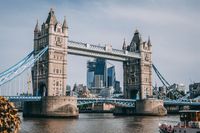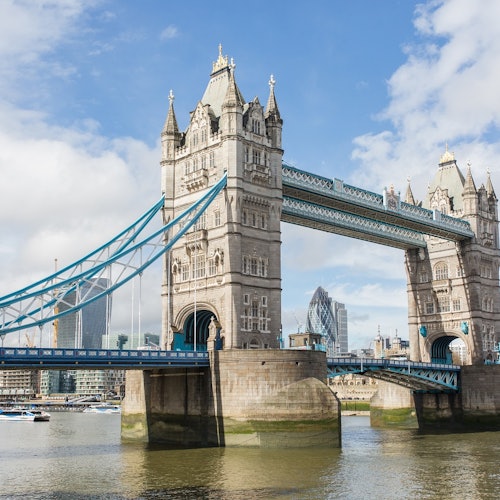
What to see at Tower Bridge?
Located in central London, the Tower Bridge is a bascule bridge which brings thousands of pedestrians and motorists to the opposite bank every day of the Thames.
It is one of the most famous monuments in London - like the Palace of Westminster (with Big Ben) or the Tower of London - and one of the most famous bridges in the world.
It can be seen from the banks of the Thames, but it is also possible to visit it!
Tower Bridge is among the best tourist attractions in London.
advertisement
Tower Bridge is one of 4 bridges managed by the Lord Mayor's Office.
History of Tower Bridge
Tower Bridge is a bascule bridge in Victorian Gothic style - built in 1894, with the aim of relieving traffic from the neighboring bridge, the London Bridge, and promoting the development of the capital towards east.
Its 2 main objectives were to:
- allow pedestrians and cars to cross the river
- give large ships the possibility of accessing the docks
In 1876, a study committee was created to work on the design of the bridge. Over 50 proposals were considered - but it was not until October 1884 that architect Horace Jones, in collaboration with engineer Sir John Wolfe Barry, presented the chosen design.
Tower Bridge belongs to the class of suspension bridges and is made of granite for its facade, steel for its structure and concrete for its foundations. It is 240 meters long, 15 meters wide and 65 meters high. It took 8 years and 432 workers to complete its construction.
Tower Bridge was officially opened on June 30, 1894 by the Prince of Wales (who became King Edward VII).
Tower Bridge was originally brown in color. It was repainted in blue, white and red in 1977 - to celebrate the Silver Jubilee of the Queen Elizabeth II.

Visit Tower Bridge
The main entrance to Tower Bridge and its ticket office are located northwest of the bridge. The engine room is located in the southern part of the bridge, at river level, on Shad Thames.
To the east of Tower Bridge you can admire the docks, Canary Wharf and Greenwich towers - while to the west you will see the skyline of City Hall, The Shard, the dome of the Saint Paul's Cathedral, the Tower of London and the towers of the City : The Gherkin, the Fenchurch Building, the Sky Garden, etc.
Blue lines painted on the ground show you the way to go.
The Gateways of Tower Bridge
The 2 walkways of Tower Bridge are 11 meters long and 1.8 meters wide and are located at a height of 96 meters.
In 2014, the installation of a glass floor - The Tower Bridge Glass Floor - in each of the bridge's walkways allows visitors to have an unusual view from the bridge and observe the road and river traffic under their feet.
Each walkway has 6 tempered glass panels 68 mm thick for a weight of about 530 kg.
If you feel dizzy, be aware that the glass floor only covers part of the walkways, it is quite possible to walk alongside.
The gateways were closed to the public in 1910 - then reopened in 1982, as part of the Tower Bridge Exhibition.
Tower Bridge Exhibition
In 1982, Tower Bridge first opened its doors to the public with an exhibition dedicated to the history of its construction.
The exhibition is still present today, you will discover a photo exhibition of the most beautiful bridges in the world, film screenings on its construction, etc.
As the monument is not air conditioned, you are strongly advised to avoid very hot days for your visit.
Allow around 1h visit.
The Tower Bridge bascule bridge
Under a law dating back to 1885, the Tower Bridge was designed so that it could pass large ships - free of charge, 365 days a year, from day and night. Boats are just required to warn of their passage at least 24 hours in advance.
Each scale of the bridge weighs approximately 1,200 tons (including a counterweight of 410 tons) - 2 huge motors with water tanks, hidden in the towers, used to power this rocking system.
The seesaws are lifted about 1 000 times a year - check out the days and times of the lifting on the official Tower Bridge website.
The glass floor does not run the entire length of the monument, it is advisable to admire the opening of the bridge from the edge of the Thames and not inside the bridge, where visibility is reduced.
In 1952, the scales of the bridge began to rise as a bus from line 78 - driven by Albert Gunter - was crossing it! The bus managed to "jump" from one seesaw to another, avoiding a fall several meters high into the Thames.
Victorian Engine Rooms: the Tower Bridge engine room
In 1894, with its hydraulic tipping mechanism that used steam to power its engines, the Tower Bridge was the most sophisticated bascule bridge in the world.
At the time, the bascule bridge technicians stayed in the engine rooms : the Victorian Engine Rooms.
Today the scales are still operated by hydraulic power, but the mechanism was automated (in 1976) and now operates on electricity.
The original engines, accumulators and pumping boilers are on display in the engine room - located below deck.
Tickets for Tower Bridge

advertisement
The ticket price for Tower Bridge includes access to the walkway and the engine room.
On site, the line at the ticket office can be very long - it is therefore advisable to book your tickets in advance, on the internet.
Entry is included with the London Pass, the London Explorer Pass and I'iVenture London Attractions Pass.
Tower Bridge opening times
Tower Bridge is open all year round:
- Autumn / Winter (October to March): every day from 9:30 a.m. to 5 p.m.
- Spring / Summer (March to September): every day from 10 a.m. to 5.30 p.m.
Like many monuments, museums and attractions, Tower Bridge is closed from December 24 to 26. It is open from 10 a.m. to 5 p.m. on January 1.
Getting to Tower Bridge
Tower Bridge sits at the intersection of Southwark and Tower Hamlets, near the Tower of London - from which it takes its name.
It is located in the Pool of London - which marks the boundary between the Upper Pool upstream and the Lower Pool downstream.
To get there, 6 options:
- Metro:
- Circle line and District line - Tower Hill stop.
- Northern line and Jubilee line - London Bridge stop.
- Bus: lines 15, 42, 78, 100 and RV1.
- Train: London Bridge, Fenchurch Street and Tower Gateway DLR stations.
- Car: Tower Hill Coach Car Park parking lot - located at 50 Lower Thames Street.
- Boat:
- North shore: St Katherine Pier and Tower Pier.
- South shore: London Bridge City Pier.
- Bicycle:
- North shore: St Katherine Way
- South shore: Tolley Street and One Tower Bridge
Near Tower Bridge
Take advantage of your visit to Tower Bridge to visit:
- Borough Market
- City Hall
- HMS Belfast
- London Bridge
- The Monument to the Great Fire of London
- The Shakespeare's Globe
- Sky Garden
- The Shard
- Tower of London